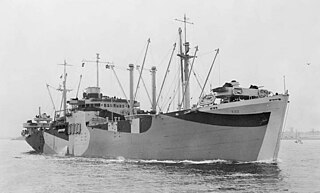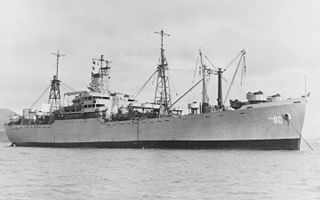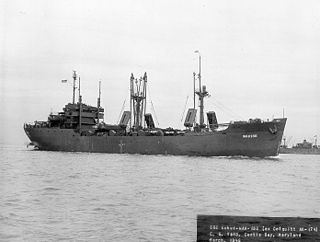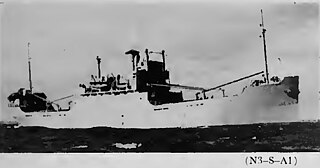
The Tacoma class of patrol frigates served in the United States Navy during World War II and the Korean War. Originally classified as gunboats (PG), they were reclassified as patrol frigates (PF) on 15 April 1943. The class is named for its lead ship, Tacoma, a Maritime Commission (MARCOM) S2-S2-AQ1 design, which in turn was named for the city of Tacoma, Washington. Twenty-one ships were transferred to the British Royal Navy, in which they were known as Colony-class frigates, and twenty-eight ships were transferred under Lend-Lease to the Soviet Navy, where they were designated as storozhevoi korabl, during World War II. All Tacoma-class ships in US service during World War II were manned by United States Coast Guard crews. Tacoma-class ships were transferred to the United States Coast Guard and various navies post-World War II.

Type C1 was a designation for small cargo ships built for the United States Maritime Commission before and during World War II. Total production was 493 ships built from 1940 to 1945. The first C1 types were the smallest of the three original Maritime Commission designs, meant for shorter routes where high speed and capacity were less important. Only a handful were delivered prior to Pearl Harbor. But many C1-A and C1-B ships were already in the works and were delivered during 1942. Many were converted to military purposes including troop transports during the war.

Type C2 ships were designed by the United States Maritime Commission (MARCOM) in 1937–38. They were all-purpose cargo ships with five holds, and U.S. shipyards built 328 of them from 1939 to 1945. Compared to ships built before 1939, the C2s were remarkable for their speed and fuel economy. Their design speed was 15.5 knots (28.7 km/h), but some could make 19 knots (35 km/h) on occasion. The first C2s were 459 feet (140 m) long, 63 feet (19 m) broad, and 40 feet (12 m) deep, with a 25-foot (8 m) draft. Later ships varied somewhat in size. Some, intended for specific trade routes, were built with significant modifications in length and capacity.
USS Charlevoix (AK-168) was an Alamosa-class cargo ship commissioned by the U.S. Navy for service in World War II. She was responsible for delivering troops, goods and equipment to locations in the war zone.

USS Chatham (AK-169) was an Alamosa-class cargo ship commissioned by the U.S. Navy for service in World War II. She was responsible for delivering troops, goods and equipment to locations in the war zone.
USS Chicot (AK-170) was an Alamosa-class cargo ship commissioned by the US Navy for service in World War II. She was responsible for delivering troops, goods and equipment to locations in the war zone.
USS Claiborne (AK-171) was an Alamosa-class cargo ship commissioned by the U.S. Navy for service in World War II. She was responsible for delivering troops, goods and equipment to locations in the war zone.
USS Clarion (AK-172) was an Alamosa-class cargo ship commissioned by the U.S. Navy for service in World War II. She was responsible for delivering troops, goods and equipment to locations in the war zone.
USS Codington (AK-173) was an Alamosa-class cargo ship commissioned by the U.S. Navy for service in World War II. She was responsible for delivering troops, goods and equipment to locations in the war zone.

USCGC Kukui (WAK-186) was a Maritime Commission Type C1-M small cargo ship launched 21 January 1945, by Froemming Brothers, Milwaukee, Wisconsin, transferred to the Navy and commissioned and designated as USS Colquitt (AK-174) 22 September 1945. Two days later the ship was transferred to the Coast Guard for operation before being permanently transferred on 11 March 1946. Renamed Kukui and designated WAK-186 the ship was the largest in the Coast Guard with notable service installing, servicing and supplying the Loran-A and Loran-C electronic navigation chain stations in the Pacific until March 1972. The ship was transferred to the Philippines to serve as the Philippine Navy's supply ship BRP Mactan (TK90) until June 2001.
USS Craighead (AK-175) was an Alamosa-class cargo ship commissioned by the U.S. Navy for service in World War II. She was responsible for delivering troops, goods and equipment to locations in the war zone.

The Type C4-class ship were the largest cargo ships built by the United States Maritime Commission (MARCOM) during World War II. The design was originally developed for the American-Hawaiian Lines in 1941, but in late 1941 the plans were taken over by the MARCOM.

USS Alcor, AK-259, was a Greenville Victory-class cargo ship in service with the United States Navy from 1952 to 1968. She was originally built in 1944 as SS Rockland Victory, a World War II era Victory ship. She was sold for scrap in 1970.

Type N3-S ships were a Maritime Commission small coastal cargo ship design to meet urgent World War II shipping needs, with the first of the 109 N3, both steam and diesel, type hulls delivered in December 1942.
The American Ship Building Company was the dominant shipbuilder on the Great Lakes before the Second World War. It started as Cleveland Shipbuilding in Cleveland, Ohio in 1888 and opened the yard in Lorain, Ohio in 1898. It changed its name to the American Ship Building Company in 1900, when it acquired Superior Shipbuilding, in Superior, Wisconsin; Toledo Shipbuilding, in Toledo, Ohio; and West Bay Shipbuilding, in West Bay City, Michigan. With the coming of World War I, the company also acquired Buffalo Dry Dock, in Buffalo, New York; Chicago Shipbuilding, in Chicago, Illinois; and Detroit Shipbuilding, in Wyandotte, Michigan. American Shipbuilding ranked 81st among United States corporations in the value of World War II military production contracts.

The Type R ship is a United States Maritime Administration (MARAD) designation for World War II refrigerated cargo ship, also called a reefer ship. The R type ship was used in World War II, Korean War, Vietnam War and the Cold War. Type R ships were used to transport perishable commodities which require temperature-controlled transportation, such as fruit, meat, fish, vegetables, dairy products and other foods. The US Maritime Commission ordered 41 new refrigerated ships for the US Navy. Because of the difficulty of building refrigerated ships only two were delivered in 1944, and just 26 were delivered in 1945 and the remainder in 1946–48. The 41 R type ships were built in four groups. Two of design types were modified type C1 ships and two were modified type C2 ships. The United Fruit Company operated many of the R type ships in World War II. The type R2-S-BV1 became the US Navy Alstede-class stores ship and the type R1-M-AV3 became the US Navy Adria-class stores ship.

The Type V ship is a United States Maritime Commission (MARCOM) designation for World War II tugboats. Type V was used in World War II, Korean War and the Vietnam War. Type V ships were used to move ships and barges. Type V tugboats were made of either steel or wood hulls. There were four types of tugboats ordered for World War II. The largest type V design was the sea worthy 186-foot (57 m) long steel hull, V4-M-A1. The V4-M-A1 design was used by a number of manufacturers; a total of 49 were built. A smaller steel hull tugboat was the 94-foot (29 m) V2-ME-A1; 26 were built. The largest wooden hull was the 148-foot (45 m) V3-S-AH2, of which 14 were built. The smaller wooden hull was the 58-foot (18 m) V2-M-AL1, which 35 were built. Most V2-M-AL1 tugboats were sent to England for the war efforts under the lend-lease act. The Type V tugs served across the globe during World War II including: Pacific War, European theatre and in the United States. SS Farallon and other Type V tugs were used to help built Normandy ports, including Mulberry harbour, on D-Day, June 6, 1944 and made nine round trips to Normandy to deliver Phoenix breakwaters.

The McDougall Duluth Shipbuilding Company was a large-scale wartime ship manufacturing shipyard, located at the city of Riverside, near Duluth. McDougall Duluth Shipbuilding was at 110 Spring Street, Duluth, Minnesota, now the site of the West Duluth's Spirit Lake Marina. The shipyard was located on St. Louis River Estuary at western part of Lake Superior. McDougall Duluth Shipbuilding Company was found by Alexander McDougall (1845-1923) in 1917 to built ships for World War I. McDougall Duluth Shipbuilding Company and the Superior Shipbuilding Company were called the Twin Ports shipbuilding industry of Minnesota and Wisconsin. Once built the ships can travel to the Atlantic Ocean through the Great Lakes and the Saint Lawrence Seaway.

Walter Butler Shipbuilders Inc. was a large-scale World War II ship manufacturing shipyard, located at Superior, Wisconsin. Walter Butler purchased the shipyard from Lake Superior Shipbuilding in 1942. Walter Butler Shipbuilders Inc. was at E 1st St, Superior, Wisconsin. The shipyard was located on the western part of Lake Superior. Walter Butler Shipbuilders Inc. was found by Walter Butler in 1942 to built ships for World War II. Walter Butler Shipbuilders Inc., the McDougall Duluth Shipbuilding Company and the Superior Shipbuilding Company were called the Twin Ports shipbuilding industry of Minnesota and Wisconsin. Once built the ships can travel to the Atlantic Ocean through the Great Lakes and the Saint Lawrence Seaway.

Bethlehem Beaumont Shipyard was a shipyard in Beaumont, Texas that opened in 1948. The yard is located on an island in the Neches River and upstream of the Sabine Pass that grants access to the Gulf of Mexico. The deep-water port shipyard was founded in 1917 as the Beaumont Shipbuilding & Dry Dock Company. Beaumont Shipbuilding & Dry Dock Company started as a World War I Emergency Shipbuilding Program yard. In 1922 the Pennsylvania Car & Foundry, of Sharon, Pennsylvania purchased the yard and renamed the yard Pennsylvania Shipyards, Inc.. The yard built barges and rail cars and also operated under the name Petroleum Iron Works at the site. For World War II the yard build tugboats and barges as part of the emergency shipbuilding program. After the war Bethlehem Steel purchased the yard in 1948 as part for the Bethlehem Shipbuilding Corporation. Bethlehem Beaumont Shipyard transitioned the yard into a jackup rig offshore drilling rig yard. The yard closed in the 1980s, with the rig market collapse. Bethlehem Steel sold the yard in 1989 to Trinity Industries. Trinity Industries purchased a Panamax floating and continued operations. The Panamax floating was moved to New Orleans in 1994. Chicago Bridge & Iron Company purchased the yard in 2006. Chicago Bridge & Iron turned the yard into a fabrication yard. In 2017 Chicago Bridge & Iron Company closed the yard due to damage from Hurricane Harvey, ending work for 455 employees. Many of workers were relocated to other Chicago Bridge & Iron sites. The site is now Allegiant Industrial Island Park Campus that opened in 2018.















